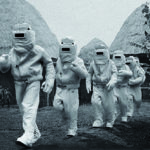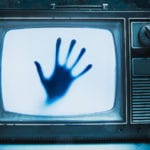 Politics
Politics  Politics
Politics  Weird Stuff
Weird Stuff Ten Bizarre Facts About The Doge Meme
 Our World
Our World 10 Ways Your Christmas Tree Is More Lit Than You Think
 Movies and TV
Movies and TV The 10 Coolest Stars to Set Sail on The Love Boat
 History
History 10 Things You Didn’t Know About the American National Anthem
 Technology
Technology Top 10 Everyday Tech Buzzwords That Hide a Darker Past
 Humans
Humans 10 Everyday Human Behaviors That Are Actually Survival Instincts
 Animals
Animals 10 Animals That Humiliated and Harmed Historical Leaders
 History
History 10 Most Influential Protests in Modern History
 Creepy
Creepy 10 More Representations of Death from Myth, Legend, and Folktale
 Politics
Politics 10 Political Scandals That Sent Crowds Into the Streets
 Weird Stuff
Weird Stuff Ten Bizarre Facts About The Doge Meme
 Our World
Our World 10 Ways Your Christmas Tree Is More Lit Than You Think
Who's Behind Listverse?

Jamie Frater
Head Editor
Jamie founded Listverse due to an insatiable desire to share fascinating, obscure, and bizarre facts. He has been a guest speaker on numerous national radio and television stations and is a five time published author.
More About Us Movies and TV
Movies and TV The 10 Coolest Stars to Set Sail on The Love Boat
 History
History 10 Things You Didn’t Know About the American National Anthem
 Technology
Technology Top 10 Everyday Tech Buzzwords That Hide a Darker Past
 Humans
Humans 10 Everyday Human Behaviors That Are Actually Survival Instincts
 Animals
Animals 10 Animals That Humiliated and Harmed Historical Leaders
 History
History 10 Most Influential Protests in Modern History
 Creepy
Creepy 10 More Representations of Death from Myth, Legend, and Folktale
10 Videos That Manipulate Your Views On Race And Gender
Some topics are guaranteed to raise hackles. Race is one. Gender is another. They’re two of the most hotly discussed issues in modern life, and most of us have firmly entrenched opinions on them.
Any video that touches on these topics is bound to get attention from people on both sides of the issue. The following videos try to dramatically change people’s opinions, with varying degrees of success.
10’10 Hours Of Walking In NYC As A Woman’
This video’s setup is simple. Actress Shoshana Roberts is filmed walking around the Big Apple for 10 hours solid. During that time, she doesn’t speak, doesn’t smile, and keeps her eyes firmly ahead. She’s dressed normally, in jeans and a T-shirt.
In the two-minute edit of the footage, we see various men speak to her. While some comments are innocuous (“good morning” or “God bless”), some are creepy. At one point, a man lurks next to her, asking why she won’t talk to him (“Is it because I’m ugly?”). At the end, the video asks you to donate to the organization that produced it.
The video inspired many parodies. It also attracted some unexpected racial controversy when people realized that none of the catcallers were white; the director had filmed white catcallers but had decided to omit them from the video. Some noted director Rob Bliss’s history of supporting gentrification and questioned his motives.
9‘#ViolenceIsViolence’
Two actors in a crowded London park pretend to get into a violent argument. In the first version of the video, the man grabs the woman by the throat. A crowd quickly forms, threatening to call the police and offering the woman shelter. In the second version, the woman assaults the man. No one intervenes. The few people who visibly react instead smile or laugh at this display of violence. The video ends with the statistic “40 percent of all domestic violence victims are men.”
The video raises an important issue about the difference between how male and female domestic violence victims are treated, and it’s an issue that we’ve covered before. However, the closing statistic has attracted some controversy. While data from the UK’s Home Office and the CDC support it as an approximation, critics note that it doesn’t take into account cases of chronic assault (more than four incidents), in which women make up 89 percent of victims.
8The Battle For Barking
Barking is an outer suburb of London, a place of unemployment and poverty. In 2006, its citizens elected to its council 12 members of the British National Party (BNP), a far-right, openly racist group. At the time, the UK press dubbed Barking “the race-hate capital of Britain.” But in 2010, Channel 4 released a documentary that brought some nuance to the story. For the first time, cameras from a national broadcaster got up close and personal with BNP party members, exposing shades of gray.
Far from playing up to the stereotype of angry white men, ordinary BNP voters turned out to be normal people seemingly abandoned by their government. One had lost a son in Afghanistan, another was the victim of extreme violence, and plenty felt that a lack of jobs and investment had left their home desolate and broken. In each case, the film explored their genuine concerns about immigration without judging them, making for some pretty uncomfortable viewing. The resulting documentary humanizes self-admitted racists and shows why we can’t just dismiss them out of hand.
7‘Canadians React To Ottawa Shooting Racism’
Relations between the West and Islam have been a tad strained since September 11, 2001. According to one poll, over half of all Americans perceive the religion as a “critical threat.” In the UK, 40 percent of the country’s mosques have been attacked in the last 13 years. With such apparent Islamophobia gripping the world, how do you think people would react to a Muslim boarding a bus just days after a local terror attack?
As the above video shows, the answer is: “reasonably.” Shot in Canada right after the Ottawa shootings of October 2014, the video features two actors: one in Islamic dress, the other playing a confrontational racist. As the Muslim actor waits at several places throughout the city, the racist harangues him for the recent attack. The filmmakers apparently thought they’d witness an explosion of racism. Instead, they saw dozens of strangers stand up for the Muslim actor.
From middle-class liberals to rednecks, everyone lines up to give the racist a piece of their mind. Each time he tries to make comments about bombings and violence, he gets shouted down. Two working-class Joes even get so infuriated that they try to beat some sense into him, leaving him with a bloody nose.
A near-identical video from Australia shows the same results. It just goes to show that despite all this talk in the media of a cultural war between religions, most ordinary people use these horrible attacks to draw together rather than push apart.
6Oppressed Majority
http://vimeo.com/86495492
Released in February 2014, the French film Majorite Opprimee (“Oppressed Majority”) makes an 11-minute drama out of the question “what would the world be like if it was run by women?” Like the “Walking in NYC” video above, it tries to show men the sort of harassment their sisters and girlfriends put up with on a daily basis but with an added twist into darker territory.
Showing a universe where women run topless and urinate in alleys, the film follows a young father as he tries to go about his daily business. Initially played like a comedy, it ultimately shows him getting sexually assaulted by a gang of teenagers and then blamed and patronized by both the police and his wife (who thinks he dresses too provocatively).
Director Eleonore Pourriat calls it an accurate representation of life as a woman in France. Others have said that it truthfully exposes the way society blames sex assault victims for being attacked.
5The Event: How Racist Are You?
In 1968, teacher Jane Elliot conducted a famous racism experiment. She divided her class into those with blue and those with brown eyes (in effect dividing the class largely into two groups, Caucasian and non-Caucasian). She then declared that blue eyes were a sign of greater intelligence and began to treat those children better. The results were immediate. The blue-eyed children began bossing their brown-eyed counterparts around, while the brown-eyed children became subservient and worse at classwork. It was a hugely influential experiment, and in 2009, Channel 4 in the UK decided to recreate it with modern, adult subjects.
The new version fails. The modern adults don’t even accept the experiment’s premise, much less respond as Jane Elliot hoped. Right at the start, two from the brown-eyed group walk out—and not because they’re offended at being called inferior. Rather, they recognize that Elliot is trying to portray the blue-eyed group as racists without evidence.
The new version may show that adults are not manipulated so easily as children. It also may show how far we’ve come in 40 years.
4Extreme South Africa: ‘The White Slums’
During the Apartheid era, South Africa’s black communities were forced into disease-ridden shantytowns. The majority of the population were kept in poverty, while the white minority lived it up. Today, although black poverty in South Africa is far from eradicated, white poverty is growing at a shocking rate. Into this new world, BBC presenter Reggie Yates spent a week in a squatters camp outside Johannesburg to investigate whether the country now discriminates against the white population.
The documentary refuses to take sides. Although the historic injustices against South Africa’s black majority were utterly horrific, the film acknowledges the dire situation many Afrikaners are now finding themselves in, as “whites only” subsidies (deservedly) become a thing of the past. From the rich black teenagers who refuse to believe any white people could live in poverty to the paranoid white slum-dwellers who hate black people with a terrifying passion, the documentary refuses to pull any punches. Aside from showing that white people aren’t always the privileged ones, it forces the viewer to question how they would try to deal with entrenched, historic discrimination.
3‘Ryland’s Story’
Even in tolerant 2014, transgender people face a lot of prejudice. As a result, around 41 percent of them will try to commit suicide at some point in their lives—nine times the national average rate. Even the left-leaning Guardian published a comment piece in 2013 calling transgenders “bedwetters in bad wigs” (they later retracted it). With all this bile flying around, it can be easy to forget that behind these statistics and headlines lie human stories. Enter YouTube video “Ryland’s Story.”
Made by Jeff and Hillary Whittington, it tells the story of their first child, Ryland, a boy born into the body of a girl. Using photographs, video clips, and some fairly cheesy music, it documents their discovery of Ryland’s true gender and how they slowly came to accept it. Is gender determined by biology, upbringing, or something else altogether? Ryland’s story makes its case persuasively and with dignity.
2The Whiteness Project
An online interactive documentary produced by PBS, The Whiteness Project featured white people talking about what it meant to them to be white. The media reacted explosively. One side claimed that the documentary tried to undeservingly portray white people as an oppressed minority. The other side said that the project tried to paint all white people as unreconstructed racists.
The truth lies somewhere in the middle. Some interviewees feel like an oppressed minority, and others feel like they’ve hit the privilege jackpot. Some feel like being white is an integral part of their identity, while others consider it only a peripheral attribute. Some have intriguing, challenging points to make; others barely say anything worth hearing at all.
As the filmmaker behind it all has stated, white people are almost never put in the position of actually thinking about their race. When it does finally happen, the results are alternately impressive, uncomfortable, and incredibly interesting.
1Femme De La Rue
In 2012, film student Sofie Peeters got fed up with the constant harassment she experienced on the streets of Brussels. Wondering if it was the types of clothes she was wearing or the way she acted, she finally decided to take a camera out with her and covertly film a typical day in her life.
A predecessor to “Walking in NYC,” the film shows the kind of harassment plenty of women experience on a daily basis, and it goes considerably further than the other video’s casual catcalls. Peeters actively tells the men who accost her to leave her alone, but they do not. In just the short clip above (the full video is also available), Peeters is openly leered at, called a whore, stalked outside a cafe, and surrounded by predatory guys. At one point, a man asks her out for a drink and then clarifies that he means in his hotel room, in his bed, not at a bar.
Unlike its New York counterpart, Femme de la Rue inspired more than online debate. Belgian legislators responded with a law fining street harassers up to €250 ($310). As of November 2014, no one has been fined under the law.




![Top 10 Most Important Nude Scenes In Movie History [Videos] Top 10 Most Important Nude Scenes In Movie History [Videos]](https://listverse.com/wp-content/uploads/2019/09/sharonstone-150x150.jpg)
![10 Episodes That Were Banned From Television [Videos—Seizure Warning] 10 Episodes That Were Banned From Television [Videos—Seizure Warning]](https://listverse.com/wp-content/uploads/2019/10/image-150x150.jpg)


